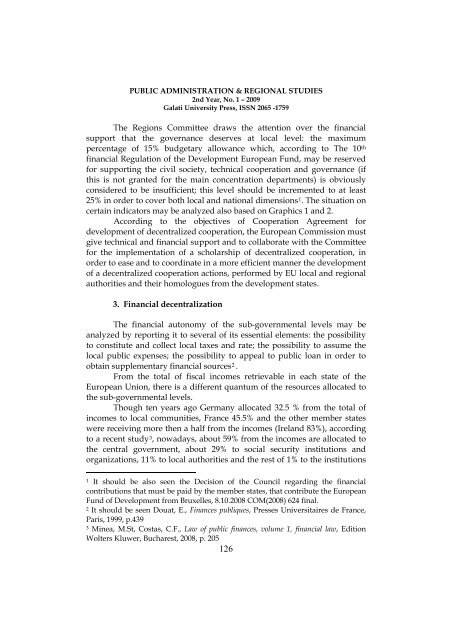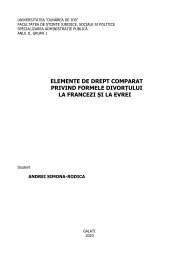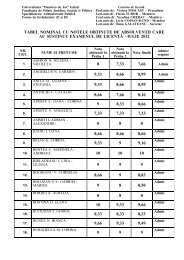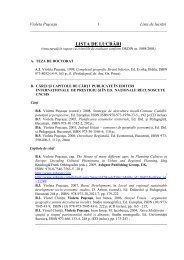regional studies public administration - Facultatea de Drept ...
regional studies public administration - Facultatea de Drept ...
regional studies public administration - Facultatea de Drept ...
You also want an ePaper? Increase the reach of your titles
YUMPU automatically turns print PDFs into web optimized ePapers that Google loves.
PUBLIC ADMINISTRATION & REGIONAL STUDIES<br />
2nd Year, No. 1 – 2009<br />
Galati University Press, ISSN 2065 -1759<br />
The Regions Committee draws the attention over the financial<br />
support that the governance <strong>de</strong>serves at local level: the maximum<br />
percentage of 15% budgetary allowance which, according to The 10 th<br />
financial Regulation of the Development European Fund, may be reserved<br />
for supporting the civil society, technical cooperation and governance (if<br />
this is not granted for the main concentration <strong>de</strong>partments) is obviously<br />
consi<strong>de</strong>red to be insufficient; this level should be incremented to at least<br />
25% in or<strong>de</strong>r to cover both local and national dimensions 1 . The situation on<br />
certain indicators may be analyzed also based on Graphics 1 and 2.<br />
According to the objectives of Cooperation Agreement for<br />
<strong>de</strong>velopment of <strong>de</strong>centralized cooperation, the European Commission must<br />
give technical and financial support and to collaborate with the Committee<br />
for the implementation of a scholarship of <strong>de</strong>centralized cooperation, in<br />
or<strong>de</strong>r to ease and to coordinate in a more efficient manner the <strong>de</strong>velopment<br />
of a <strong>de</strong>centralized cooperation actions, performed by EU local and <strong>regional</strong><br />
authorities and their homologues from the <strong>de</strong>velopment states.<br />
3. Financial <strong>de</strong>centralization<br />
The financial autonomy of the sub-governmental levels may be<br />
analyzed by reporting it to several of its essential elements: the possibility<br />
to constitute and collect local taxes and rate; the possibility to assume the<br />
local <strong>public</strong> expenses; the possibility to appeal to <strong>public</strong> loan in or<strong>de</strong>r to<br />
obtain supplementary financial sources 2 .<br />
From the total of fiscal incomes retrievable in each state of the<br />
European Union, there is a different quantum of the resources allocated to<br />
the sub-governmental levels.<br />
Though ten years ago Germany allocated 32.5 % from the total of<br />
incomes to local communities, France 45.5% and the other member states<br />
were receiving more then a half from the incomes (Ireland 83%), according<br />
to a recent study 3 , nowadays, about 59% from the incomes are allocated to<br />
the central government, about 29% to social security institutions and<br />
organizations, 11% to local authorities and the rest of 1% to the institutions<br />
1 It should be also seen the Decision of the Council regarding the financial<br />
contributions that must be paid by the member states, that contribute the European<br />
Fund of Development from Bruxelles, 8.10.2008 COM(2008) 624 final.<br />
2 It should be seen Douat, E., Finances publiques, Presses Universitaires <strong>de</strong> France,<br />
Paris, 1999, p.439<br />
3 Minea, M.St, Costas, C.F., Law of <strong>public</strong> finances, volume 1, financial law, Edition<br />
Wolters Kluwer, Bucharest, 2008, p. 205<br />
126

















